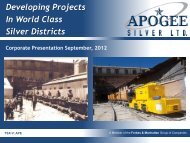Pulacayo Project Feasibility Study - Apogee Silver
Pulacayo Project Feasibility Study - Apogee Silver
Pulacayo Project Feasibility Study - Apogee Silver
You also want an ePaper? Increase the reach of your titles
YUMPU automatically turns print PDFs into web optimized ePapers that Google loves.
<strong>Pulacayo</strong> 1 000 t/d Phase I <strong>Feasibility</strong> <strong>Study</strong> - NI 43-101 Technical Report<br />
090644-3-0000-20-IFI-100<br />
used the Environmental Quality Standard for Soil Resources and Criteria for Contaminated Soil<br />
Remediation of the Republic of Ecuador.<br />
The sample with the highest number of non-standard parameters, was obtained in the ELBA of<br />
the dry season from an area of land in the area called Tajo, where there is the presence of mining<br />
environmental threats in the area of sampling and also in the surrounding ones, that coupled with<br />
the action of climatic factors (mainly rain and wind), generated pollution due to dragging of<br />
material.<br />
The parameters that are beyond the norm, recurrent in all samples and in all studies are arsenic,<br />
zinc, lead and cadmium.<br />
20.3.4 Sediment Quality<br />
To evaluate the quality of sediments in the area of the <strong>Pulacayo</strong> Mining <strong>Project</strong>, 7 sampling points<br />
were collected for studies of dry season and wet season respectively. To compare with the<br />
reference values, Medmin used the Canadian Sediment Guidelines for the Protection of Aquatic<br />
Life, because Bolivia does not have its own regulations.<br />
The sample with the highest number of parameters beyond the Canadian standard is the one<br />
taken from the Huanchaca River, with a total of 5 exceeding parameters. This situation is mainly<br />
due to the presence of mining environmental threats in the sampling area and surrounding areas,<br />
which together with the action of climatic factors (mainly rain and wind) generated pollution<br />
thereof due to entrainment of material in the basin of the river aforesaid.<br />
The parameters that are beyond the norm, more recurrent in all samples, in all studies, are<br />
Arsenic, Lead, Zinc and Cadmium.<br />
20.3.5 Drinking Water Quality (Drinking Water Distribution System)<br />
The <strong>Pulacayo</strong> mining center uses surface water from different sources, such as the snow thaws<br />
of the Cosuño mountain, the streams of Huayllas and Juskuni, these water sources are stored in<br />
the dam Yanapollera, Huayllas pond and Juskuni pond respectively. The distribution of water in<br />
the town of <strong>Pulacayo</strong> is made by plumbing and is done directly from the source.<br />
To study the quality of drinking water two sample collection campaigns were made, one in the dry<br />
season and one in the wet season, in order to evaluate and compare the data and get a better<br />
interpretation of the results and variations throughout the year.<br />
The results of quality of drinking water shows that the water quality is good in the ponds Huayllas<br />
and Juskuni throughout the year, the latter being the best quality. The water quality of the<br />
Yanapollera dam is low during the wet season; however, during the dry season this water<br />
improves its quality but still presents contamination by whole coliforms contamination, reducing<br />
its concentration relative to the sample obtained in wet season.<br />
20.3.6 Condition of Flora and Fauna<br />
The <strong>Pulacayo</strong> Mining <strong>Project</strong> is not within any protected areas of Bolivia. The characterization of<br />
eco-biological components according to the classification by eco-regions and sub-Eco regions<br />
(Ibisch et al. 2003), indicates that the project area lies within two major sub-Eco regions:<br />
TWP Sudamérica S.A. Av. Encalada 1257 Of. 801, Santiago de Surco Lima 33, Perú (51-1) 4377473<br />
Page 243



